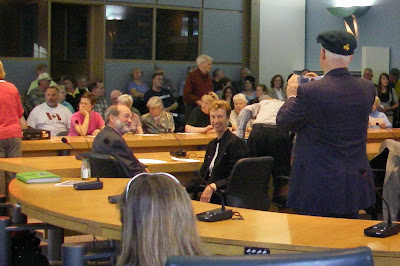I know I just posted a blog post about the Corktown Footbridge, and I've previously covered the opening, but in honour of St. Patrick's Day—and my just-over-one-eighth Irish heritage—I'm reprinting the article I wrote in this month's issue of the Centretown Buzz, telling the story of my time on the naming committee for what is now the Corktown Footbridge.
The words “Corkstown Bridge” on the cover of the February BUZZ made me cringe, having been on the committee to call it the Corktown Footbridge. With spring nearing, it’s worth sharing the story of how the name came about. Two days into spring of 2007, community representatives from both sides of the Canal were gathered by Councillors Diane Holmes and Georges Bédard in a small meeting room.
The Pedestrian Bridge Naming Committee included members of the Centretown Citizens’ Community Association, Action Sandy Hill, Heritage Ottawa, and the University of Ottawa. I sat on the committee as president of Citizens for Safe Cycling.
The committee mandate to find a name for the bridge was actually unprecedented, to the extent that the City’s Commemorative Naming Policy only provided for situations where someone wants to commemorate a specific person.
We met four times, paring down the submissions first to eight names, then a shortlist of three: Charlotte Whitton, Corktown, and Somerset. The Charlotte Whitton suggestion elicited strong opposition, much as it did years later when Mayor Watson floated the name of Ottawa’s first female mayor for the new City Archives building.
Somerset was favoured by some for navigational reasons, though the City’s technical folks worried it might be confused with the bridge over the O-Train tracks. The strongest support was for Corktown. While Colonel By is celebrated for supervising the construction of the Rideau Canal, it was mostly Irish who provided the labour. They lived in an encampment on the west bank of the canal called “Corktown” (and in some documents, “Corkstown”) after County Cork in Ireland, from which most of them had emigrated. Corkstown Road in the west end has a similar origin story.
The Irish weren’t represented in the bridges over the Rideau Canal, but the Laurier and Mackenzie King bridges can be said to reflect the French-Canadian and Scottish-English founding communities of Bytown/Ottawa. Rather than celebrating one powerful person, the name Corktown helped to commemorate the many unknown workers who toiled and died in the construction of the locally and nationally significant canal.
Last, the committee agreed to call it a “footbridge” rather than a “pedestrian bridge,” which was snappier and more inclusive of all foot-powered modes, including bicycles.
On May 29, the sponsoring councillors hosted a community meeting at City Hall to conduct a “straw poll” vote for the three names. The Irish community had a celebration (a “ceili”) outside City Hall before the meeting and attracted so many enthusiastic supporters that we had to move to a bigger room! Each person received a dot sticker to place on the poster with their preferred name for the bridge.
Corktown won overwhelmingly, with over 150 dots, with fewer than five for Somerset and Charlotte Whitton.
With this clear mandate, Councillors Holmes and Bédard presented a motion to Ottawa City Council and on June 13, 2007, just a few days before the end of spring, the bridge was formally and officially named Passerelle Corktown Footbridge. The ribbon was cut on September 11, 2007, with many community members, politicians, and costumed volunteers from the Bytown Museum on hand to celebrate.
If you're looking for more history on the Corktown Footbridge, check out the Pedbridge blog I maintained during the bridge's construction. (I'm working to re-link the broken images)





.JPG)

Ironically, most people I know who live in east Centretown call this the Someset Street Footbridge; few call it by its official name. Its good that there is a historic plaque though with the name.
ReplyDelete